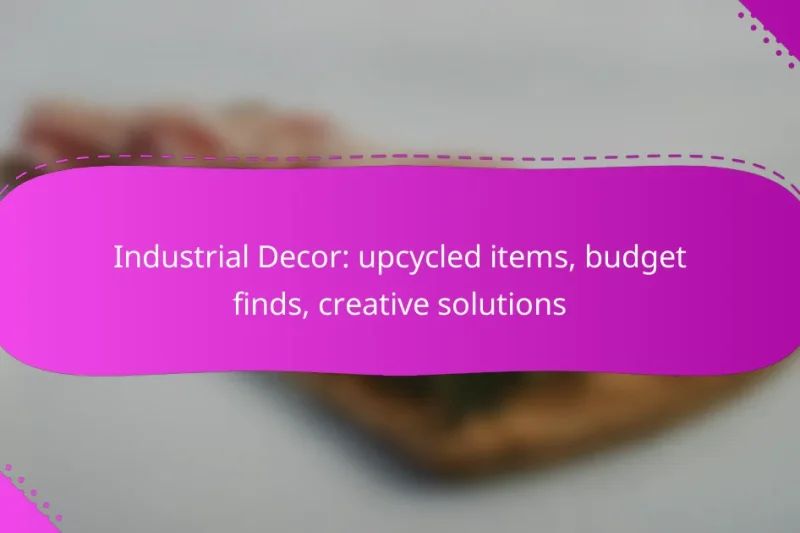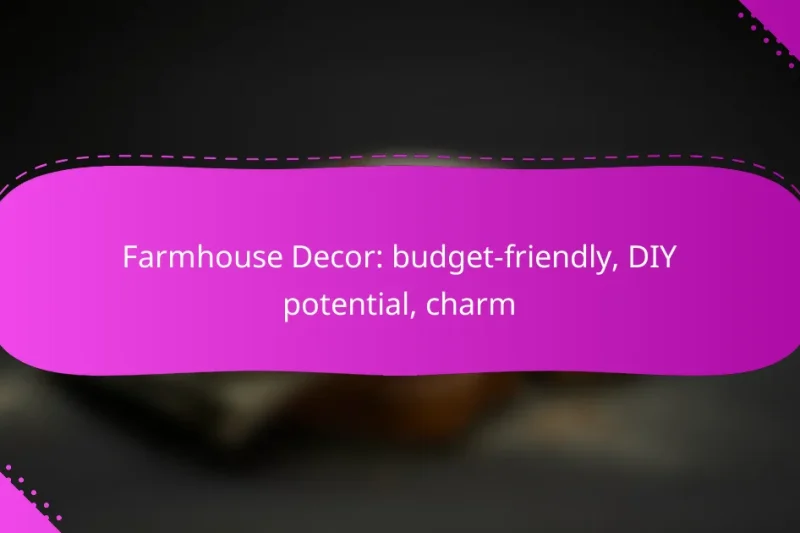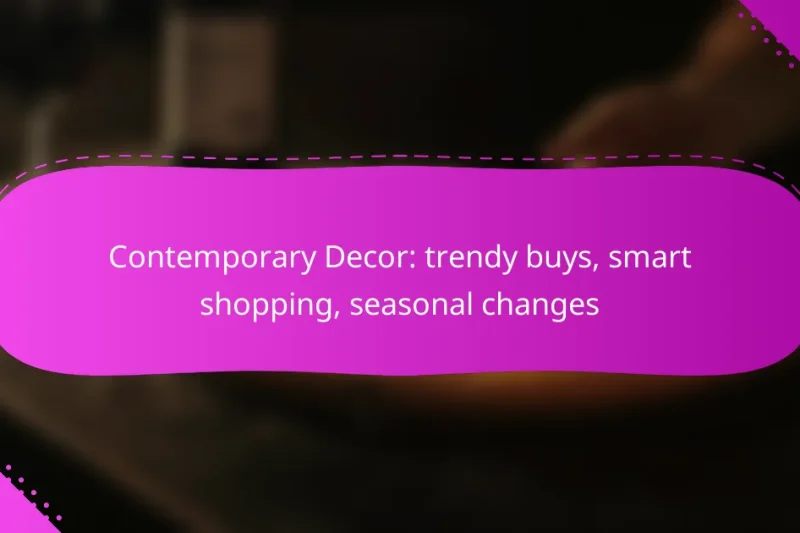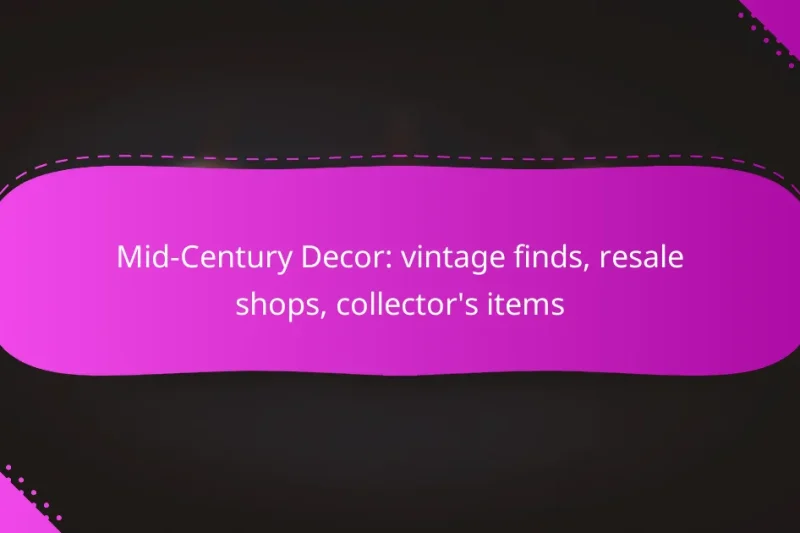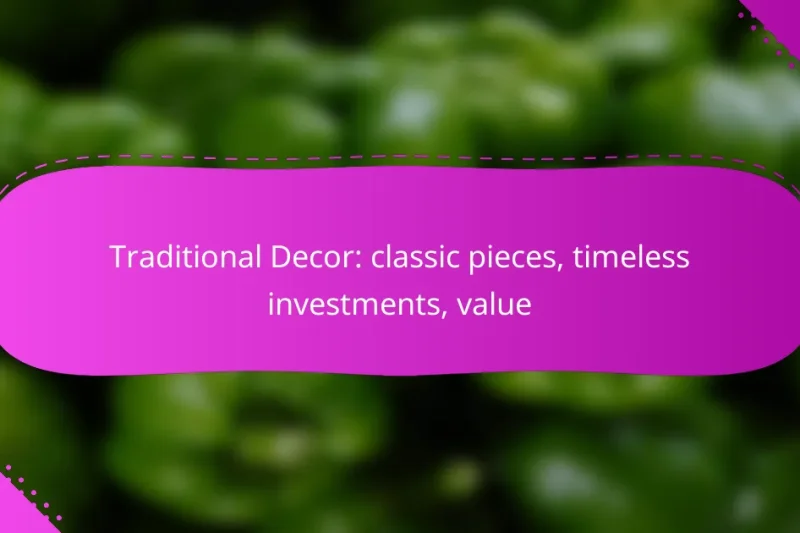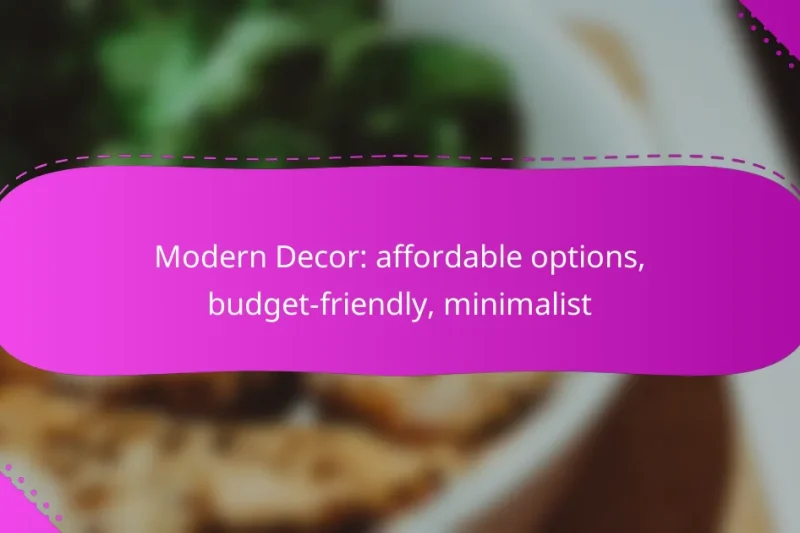Eclectic decor is all about blending diverse styles, colors, and textures to create a space that … Eclectic Decor: mix and match, creative sourcing, personalityRead more
Budgeting for Different Decor Styles
Budgeting for different decor styles requires an understanding of each aesthetic’s unique elements and priorities. Whether you’re drawn to the simplicity of minimalist design, the eclectic charm of Bohemian decor, or the rugged appeal of industrial style, effective budgeting can help you achieve your vision without breaking the bank. By focusing on essential items and key features, you can create a beautiful space that reflects your personal style while staying within your financial limits.
Art Deco Decor: statement pieces, investment quality, uniqueness
Art Deco decor is renowned for its unique blend of elegance and modernity, characterized by bold … Art Deco Decor: statement pieces, investment quality, uniquenessRead more
Industrial Decor: upcycled items, budget finds, creative solutions
Industrial decor embraces a raw, rugged aesthetic that can be beautifully enhanced by incorporating upcycled items, … Industrial Decor: upcycled items, budget finds, creative solutionsRead more
Farmhouse Decor: budget-friendly, DIY potential, charm
Transforming your home with budget-friendly farmhouse decor is both achievable and rewarding. By utilizing affordable materials … Farmhouse Decor: budget-friendly, DIY potential, charmRead more
Bohemian Decor: thrifted pieces, low-cost decor, personal flair
Bohemian decor embraces individuality and creativity, making it the perfect style for incorporating thrifted pieces that … Bohemian Decor: thrifted pieces, low-cost decor, personal flairRead more
Coastal Decor: affordable accents, natural elements, simplicity
Transform your home into a serene coastal retreat with affordable decor that emphasizes natural elements and … Coastal Decor: affordable accents, natural elements, simplicityRead more
Contemporary Decor: trendy buys, smart shopping, seasonal changes
Contemporary decor trends emphasize creating inviting, functional spaces that showcase personal style through elements like biophilic … Contemporary Decor: trendy buys, smart shopping, seasonal changesRead more
Mid-Century Decor: vintage finds, resale shops, collector’s items
Mid-Century decor offers a captivating glimpse into design history, characterized by clean lines and organic forms … Mid-Century Decor: vintage finds, resale shops, collector’s itemsRead more
Traditional Decor: classic pieces, timeless investments, value
Traditional decor embodies timeless elegance and craftsmanship, making it an ideal choice for classic homes. Investing … Traditional Decor: classic pieces, timeless investments, valueRead more
Modern Decor: affordable options, budget-friendly, minimalist
Modern decor can be both stylish and budget-friendly, allowing you to achieve a minimalist aesthetic without … Modern Decor: affordable options, budget-friendly, minimalistRead more
How to Budget for Minimalist Decor in London?
Budgeting for minimalist decor in London involves prioritizing simplicity and functionality while keeping costs manageable. Focus on essential items, choose a neutral color scheme, and consider multifunctional furniture to create a clean and uncluttered space without overspending.
Focus on essential furniture
When budgeting for minimalist decor, concentrate on essential furniture pieces that serve multiple purposes. For example, a simple sofa bed can function as both seating and a sleeping area, saving space and money. Aim to spend around £500 to £1,000 on key items, ensuring they are durable and versatile.
Consider second-hand options or local marketplaces to find quality furniture at lower prices. This approach not only helps your budget but also aligns with the minimalist ethos of reducing waste.
Choose neutral color palettes
A neutral color palette is a hallmark of minimalist decor and can help create a serene environment. Shades like white, beige, and grey can be used to make spaces appear larger and more cohesive. Paint costs in London typically range from £20 to £50 per gallon, so plan for this expense when budgeting.
Incorporate texture through fabrics and materials rather than bold colors to maintain interest without clutter. This strategy allows you to keep your decor simple yet stylish.
Invest in multifunctional pieces
Investing in multifunctional furniture is crucial for minimalist decor, especially in smaller London apartments. Look for items like ottomans with storage, coffee tables that convert into desks, or shelving units that can double as room dividers. These pieces can range from £200 to £800 depending on quality and design.
By choosing multifunctional items, you can maximize your space while minimizing the number of pieces needed, keeping your budget in check.
Utilize DIY decor options
DIY decor options can significantly reduce costs while allowing for personal expression in minimalist spaces. Simple projects like creating wall art from reclaimed materials or building your own shelving can be both budget-friendly and fulfilling. Consider allocating around £100 to £300 for supplies, depending on the complexity of your projects.
Research online tutorials or local workshops to gain skills and ideas that fit your minimalist theme. This approach not only saves money but also adds a unique touch to your home.
What is the cost of Bohemian Decor in the UK?
The cost of Bohemian decor in the UK can vary widely, typically ranging from a few hundred to several thousand pounds depending on the quality and quantity of items chosen. Key factors include the types of textiles, furniture, and art pieces that embody the eclectic and relaxed style characteristic of Bohemian design.
Average price range for textiles
Textiles are a cornerstone of Bohemian decor, with prices for items like rugs, cushions, and throws generally falling between £20 and £200 each. Vintage or handmade pieces may cost more, while mass-produced items can be found at lower prices.
When budgeting for textiles, consider mixing high-end items with affordable finds to create a layered look without overspending. Thrift shops and online marketplaces often have unique options that fit the Bohemian aesthetic.
Budgeting for vintage furniture
Vintage furniture is essential for achieving a Bohemian vibe, with costs typically ranging from £50 to £500 per piece, depending on the rarity and condition. Items like chairs, tables, and cabinets can often be sourced from local antique shops or online platforms.
To save money, look for pieces that require minor repairs or refinishing. This approach not only reduces costs but also allows for personalization, making the furniture truly unique to your space.
Cost-effective wall art options
Wall art in a Bohemian setting can be sourced affordably, with options ranging from £10 for prints to £100 for original pieces. Consider creating a gallery wall using a mix of framed prints, textiles, and personal photographs to keep costs down while adding character.
DIY art projects can also be a budget-friendly way to enhance your decor. Simple techniques like painting or using fabric scraps can yield stunning results without breaking the bank.
How to allocate funds for Industrial Style Decor?
To effectively allocate funds for industrial style decor, focus on key elements that define this aesthetic, such as raw materials and statement pieces. Prioritizing these aspects will help create a cohesive look without overspending.
Prioritize raw materials
Raw materials are the backbone of industrial decor, emphasizing a rugged, unfinished look. Allocate a significant portion of your budget to materials like metal, concrete, and exposed brick, which can often be more affordable than finished products.
Consider sourcing materials from local suppliers or salvage yards to reduce costs. Using reclaimed or surplus materials can not only save money but also add character to your space.
Invest in statement lighting
Statement lighting is crucial in industrial decor, serving as both a functional and decorative element. Allocate funds for unique fixtures, such as pendant lights or vintage-style bulbs, which can range from moderate to high prices depending on design and brand.
Look for lighting options that incorporate metal and glass to enhance the industrial feel. Shopping at specialty stores or online marketplaces can yield distinctive finds that fit your budget.
Consider reclaimed wood furniture
Reclaimed wood furniture is an excellent choice for industrial decor, offering a rustic charm while being environmentally friendly. Investing in a few key pieces, such as tables or shelving, can create focal points in your space.
Prices for reclaimed wood furniture can vary widely, so explore local artisans or online platforms that specialize in sustainable furniture. This approach not only supports local businesses but also allows for unique, one-of-a-kind items in your home.
What are the key factors in budgeting for Scandinavian Decor?
When budgeting for Scandinavian decor, focus on simplicity, functionality, and the use of natural materials. These elements not only define the style but also influence overall costs, making it essential to plan accordingly.
Focus on simplicity and functionality
Scandinavian decor emphasizes clean lines and minimalism, which can help reduce costs by limiting the number of decorative items. Prioritize furniture that serves multiple purposes, such as a coffee table with storage, to maximize both functionality and budget efficiency.
Consider investing in fewer, high-quality pieces rather than numerous lower-quality items. This approach aligns with the Scandinavian philosophy of valuing craftsmanship and durability, ultimately saving money in the long run.
Average costs for light wood furniture
Light wood furniture is a staple in Scandinavian design, typically made from materials like pine, birch, or ash. Prices for such furniture can vary widely, with basic pieces starting around $100 and more intricate designs reaching up to $1,000 or more.
To budget effectively, consider shopping at both local and online retailers. Many offer a range of options, from affordable flat-pack furniture to bespoke items, allowing you to find pieces that fit your budget without compromising on style.
Importance of natural lighting
Natural lighting plays a crucial role in Scandinavian decor, enhancing the airy and open feel of spaces. When budgeting, factor in window treatments that allow light to flow in, such as sheer curtains or blinds, which can range from $20 to $200 depending on the material and size.
Maximizing natural light can reduce the need for artificial lighting, leading to lower electricity costs. Consider using mirrors strategically to reflect light and make spaces feel larger and brighter, which can enhance the overall aesthetic without significant expense.
How to compare costs of different decor styles?
Comparing costs of different decor styles involves analyzing both initial expenses and ongoing maintenance. Each style has distinct characteristics that can significantly affect your budget, so understanding these differences is crucial for making informed decisions.
Create a decor style comparison chart
To effectively compare decor styles, create a chart that outlines key features, costs, and maintenance requirements for each style. Include categories such as furniture, accessories, and installation costs. This visual representation will help you quickly assess which styles fit your budget.
For example, a minimalist style may require fewer items, leading to lower initial costs, while a traditional style might involve higher expenses due to more elaborate furnishings. Consider using a simple table format to organize this information clearly.
Evaluate long-term investment vs. short-term costs
When budgeting for decor styles, weigh long-term investments against short-term costs. Some styles may have higher upfront costs but offer durability and timeless appeal, potentially saving money over time. For instance, investing in quality materials for a modern style can reduce the need for frequent replacements.
Conversely, trendy styles may be cheaper initially but could require updates or replacements more often, leading to higher long-term expenses. Assess your lifestyle and how long you plan to maintain the decor to make the best financial decision.
What are the best budgeting tools for home decor?
The best budgeting tools for home decor help you manage expenses effectively while planning your design projects. Popular options include budgeting apps and spreadsheets, which can simplify tracking costs and staying within your financial limits.
Using budgeting apps like YNAB
Apps like You Need A Budget (YNAB) are designed to help users allocate their funds effectively for various expenses, including home decor. YNAB encourages proactive budgeting by allowing you to assign every dollar a job, which is particularly useful when planning for specific decor styles.
With YNAB, you can set goals for each project and track your spending in real-time. This visibility helps prevent overspending and ensures that you stay aligned with your overall budget. Many users find that the app’s educational resources enhance their budgeting skills.
Spreadsheets for tracking expenses
Using spreadsheets to track expenses is a flexible and customizable method for budgeting home decor projects. You can create a simple table to list items, their costs, and the total expenditure, allowing for easy updates as you shop.
Consider including columns for categories like furniture, paint, and accessories, along with a running total. This method is particularly effective for those who prefer a hands-on approach and can easily adjust their plans as needed. Just be cautious of not letting the spreadsheet become too complex, which can lead to confusion.
How to plan for seasonal decor changes?
Planning for seasonal decor changes involves anticipating shifts in style and theme throughout the year. By budgeting appropriately and selecting versatile pieces, you can refresh your space without overspending.
Assess your current decor
Start by evaluating your existing decor to identify what can be reused or repurposed for different seasons. Consider items that can easily transition between themes, such as neutral-colored furniture or basic decorative elements.
Make a list of these items and categorize them based on their seasonal relevance. This will help you determine what additional pieces you may need to purchase for a cohesive look.
Set a seasonal budget
Establish a budget for each season that reflects your overall financial plan for decor. A reasonable range might be 10-20% of your total decor budget allocated for seasonal updates.
Consider prioritizing larger investments in key pieces that can be used across multiple seasons, while reserving smaller amounts for trendy items that may only last a season.
Shop strategically
When shopping for seasonal decor, look for sales and discounts, especially during off-peak times. Many retailers offer significant markdowns after holidays, making it an ideal time to stock up on decor for the next season.
Additionally, consider thrift stores or online marketplaces for unique finds that can add character to your seasonal displays without breaking the bank.
Store and maintain decor
Proper storage of seasonal decor is crucial to maintaining its quality. Use labeled bins to keep items organized and protected from damage. Consider climate-controlled storage if you have valuable pieces that could be affected by humidity or temperature changes.
Regularly inspect your decor for wear and tear, and replace any damaged items as needed to ensure your seasonal displays remain fresh and appealing.


